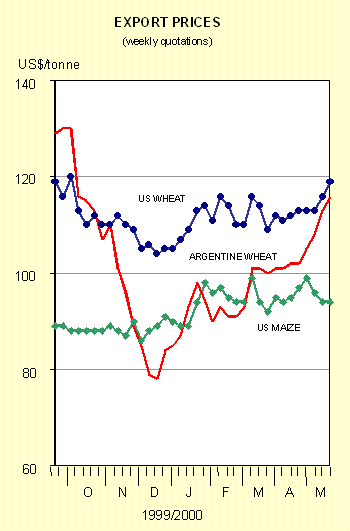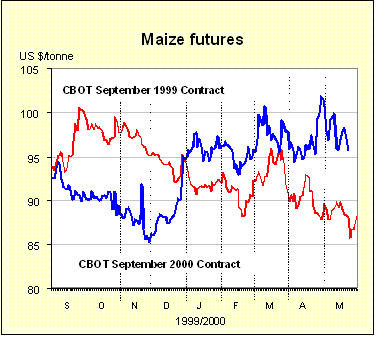


International wheat prices in May edged slightly higher as the overall bearish sentiment which characterized the price developments in earlier months gave way to some upside movements, mainly in response to less favourable crop weather conditions in the United States. In May, the U.S. wheat No. 2 (HRW, fob) averaged around US$116 per tonne, up US$4 per tonne from March and also US$4 per tonne more than in the corresponding period in the previous year. Similarly, wheat futures have also strengthened in recent weeks. By late May, the September wheat futures for soft red winter at the Chicago Board of Trade (CBOT) were quoted at US$107 per tonne, up US$12 per tonne from the previous year.

International wheat prices are expected to gradually trend higher in the coming marketing season. With harvests getting underway soon in most wheat producing countries in the northern hemisphere, seasonal factors could put downward pressure on prices. However, the overall supply and demand picture for next season could prove more supportive, especially in view of relatively strong import demand in Asia and North Africa as well as slightly reduced exportable supplies in some countries.
| 2000 | 1999 | ||
| May | March | May | |
| (. . . . . . US$/tonne . . . . . .) | |||
| United States | |||
| Wheat 1/ | 116 | 112 | 112 |
| Maize | 95 | 95 | 93 |
| Sorghum | 95 | 95 | 89 |
| Argentina 2/ | |||
| Wheat | 112 | 98 | 121 |
| Maize | 87 | 85 | 98 |
| Thailand 2/ | |||
| Rice white 3/ | 210 | 232 | 252 |
| Rice, broken 4/ | 143 | 151 | 185 |

At this time of the year, the international maize market is usually trading largely on the weather situation and the size and condition of the new crop in the United States, which also explains the more volatile nature of price developments since mid-April. Earlier in May, the U.S. maize prices rose sharply but lost most of their momentum later in the month. Overall, however, the U.S. No. 2 maize (fob) averaged US$95 per tonne in May, unchanged from March but US$2 per tonne above the corresponding period last year. The CBOT maize futures also continued to remain above last year's values despite some weaknesses later in the month, mostly in response to reports of record planting pace in the United States. In the near-term, however, the outlook for maize prices is rather uncertain, much depending on the eventual size of exportable supplies in China along with demand prospects in several major Asian markets in the aftermath of the recent outbreak of the foot-and-mouth disease.
The general trend of declining international rice prices persisted through May, as the global import demand is still low relative to export supplies. As a result, the FAO Export Price Index for Rice (1982-84=100) fell a further 2 points from April to average 98 points in May, 15 points below a year earlier and the lowest level since September 1993. Although low prices are a welcome development for those LIFDC that depend on rice imports to meet their food requirements, they are seriously hurting those developing countries that rely on rice exports as a major source of foreign exchange. Because of their depressing effects on farmers' incomes, low international rice prices are also a cause of concern for importing countries that have reduced protective border measures.

Prices from most origins fell in May with the price for high quality Thai 100% B falling by US$6 per tonne from its April average to US$210 per tonne, the lowest level in about seven years. Over the same period, prices of the lower quality fully broken rice (Thai A1 Super) dropped by US$4 to US$143 per tonne, the lowest level since June 1990. Prices from other Asian origins were also under downward pressure during May. However, prices for Thai Fragrant rice were some of the very few that registered an increase during the month as demand for that rice quality, by countries such as China, remained firm.
In the United States, the market was a little bit more active than in the previous month, stirred by increased interest for some grades from its traditional customers in Central and South America. As a result, prices did not fall as much during the month compared to other origins. The monthly average price for the high quality No. 2/4 percent broken rice averaged US$258 per tonne in May, down by US$1 per tonne from April and the lowest level in about 13 years. A much stronger import demand would be needed to bring a sustainable upward swing in prices given that supplies are at record levels in the country.
In the next few weeks, international rice prices will be influenced by firmer information about the expected paddy output levels in the major exporting and importing countries that are to be harvested during the second half of the year.